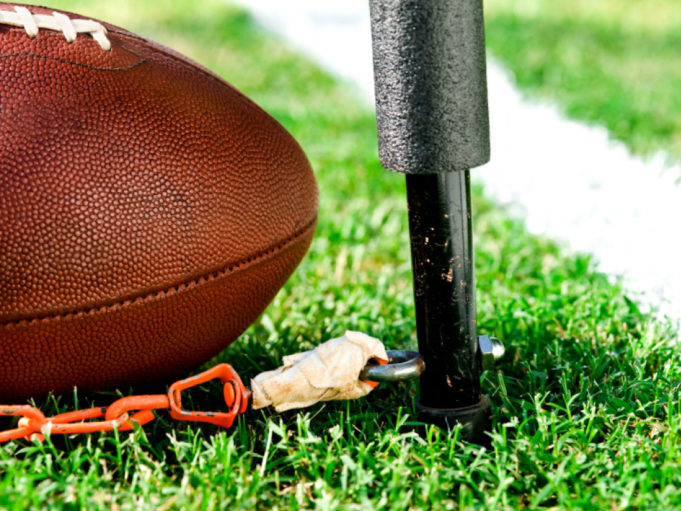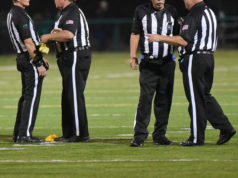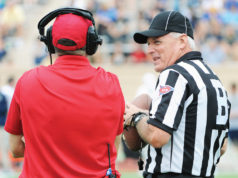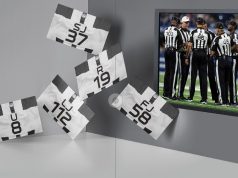1Because it has to be done on nearly every play, ball placement is one of the most important elements of officiating a football game. My experience is that it’s also a phase of the game that involves a relatively high degree of error, especially in the lower ranks with four- or five-official crews. It can be difficult to get an accurate spot downfield on a long run or pass play. Errors are in part a function of the fact that so many things can happen that the human eye has a difficult time tracking — the runner’s knee touching the ground an instant before we see it do so, the runner bouncing along the ground after he lands so that the ball ends up farther downfield than it should be, etc. But they can also be attributable to a lack of focus on our part. To spot the ball properly, play in and play out throughout the entire game, the wing officials have to concentrate 100 percent on what is happening in front of them and can never let up. And even then, mistakes will be made.
A game with perfect spots is, however, something to continually strive for, and there are some principles that can help us along the way. (Full disclosure: I never was a wing official, so what follows is what I’ve picked up over the years from working with some really top-notch individuals.)
Let’s start with free kicks. If you’re working on a field with marks indicating all of the yardlines (not just lines every five yards), spot the ball with its nose on a yardline when the play ends. That will enable the crew to more easily determine whether a first down is made in the sequence of plays that follows, because the officials will know that if the nose of the ball gets past the yardline 10 yards away, a first down has been made. That will also allow the chains to be more accurately set than if the ball is spotted between two yardlines.
Do the same thing on punts. A few inches isn’t going to make a big difference in the overall scheme of things, so as a general rule let’s just make it easier on ourselves by spotting the ball with the nose end touching a yardline. The only exception is if the kicking team manages to down the ball a foot short of the goalline; then spot the ball right there instead of on the one yardline. Otherwise you deprive the kickers of the full effect of their outstanding play.
On scrimmage plays, the wing officials have to be eternally vigilant lest some part of the runner’s body other than his hand or foot touches the ground before you think it did so that the play should end and the whistle should be blown. I realize that circumstances can make that a tough look and a tough call — players can get in our way, for example — but that is where the need to be 100 percent focused at all times comes in.
Judging double action
Then the question becomes, exactly where was the ball at the instant that the runner’s knee (or some other body part) touched the ground? Often plays like that involve “double action” where, for example, the runner’s arm is at an angle when his elbow hits the ground and it then falls forward. Too often, officials spot the ball where it is when the arm ends up stretched out on the ground, not where it was the instant the elbow touched. Depending on the runner, that could make a difference of as much as a couple of feet.
Getting that right can be easier if you’ll visualize that happening — elbow or knee hits with the runner’s arm (and ball) in the air, arm falls forward. In that case, place the ball where it was when the elbow or knee hit. I’ve had wing officials tell me they have seen that play in their mind’s eye so many times that ruling accurately on the field almost becomes second nature.
Sometimes it can be difficult to see the ball, and then educated guesses have to be made. On a quarterback sneak on third down and a yard to go, for example, the runner can quickly get lost in the surging mass of humanity. There is little alternative but to sense where the runner ends up when the mass stops moving. If you surmise that the ball will be roughly in the bottom of his rib cage, where it usually is, you can put two and two together and come up with an accurate spot. Be careful, of course, not to blow the whistle too quickly, as it can be an awful feeling trying to sell forward progress that you know deep down inside is erroneous because the ball came out and the defense recovered but you didn’t see it so you killed the play.
On plays like that, as on those where it’s close to a first down but you get a good look at the ball, the wing officials need to sell the spot by busting in toward the pile as if they know exactly where they’re going. The one that has the best look should take over the play and insist that the ball be given to him to spot. The other should mirror him. Don’t come in at an angle or moving from side to side, and don’t move your feet once you decide where to spot the ball, because then it looks to the world like you really haven’t a clue. Maybe you don’t, but you can’t afford to convey that message. Come barreling in on a straight line, put your foot where you think the ball should be spotted and keep it there.
Also, on close line-to-gain plays, don’t stand out to the side of the field and have the ball thrown to your spot. That looks awful when the referee then calls for the chains to measure. Get into where the pile is.
Crossfield spotting
Sometimes one wing official may need to get help from the other. If, for example, the ball is thrown toward the sideline 10 or 15 yards downfield and the receiver catches it and is immediately driven back, the official on that side may not have a good look at where forward progress was stopped. On reading pass, however, the wing official on the opposite side should quickly move downfield so he will have an acrossthe- field look. He may not be exactly right in terms of where he concludes the play stopped, but he’ll likely be more accurate than his partner. Using crossfield mechanics, that partner can now move up, glance across the field and seamlessly put his feet at the spot indicated by the opposite wing. No one will be the wiser.
When the runner goes out of bounds, be careful not to be so focused on the spot that you don’t continue to work the play.
In a game for which I was the replay official, the crew missed a blindside block on a punt return. The returner was about to go out of bounds. A teammate about five yards inbounds nailed an opponent. I’m convinced the field judge was too focused on the spot. Had he not, he almost certainly would have seen the foul.
I used to see that happen a lot in lower levels of ball. Officials on out of- bounds plays would virtually stick their nose in the ground where the runner went out, instead of watching what happened to the runner when he ended up in the opposing bench area. In seven-official crews, other officials can help the wing official. But in a four- or five-official crew, that wing official may be the only one who can follow action around the runner and then the continuing action after he goes out of bounds.
Another thing that can happen on out-of-bounds plays is that you don’t process where the ball was when the runner stepped out of bounds. The proper spot is not where the runner went out of bounds, but instead is where the ball was when he did so. Depending on the runner’s position when he stepped out of bounds, the ball could be a good two or three feet beyond that spot, and that is where the ball needs to be spotted.
A game with 100 percent accurate spots is not likely to occur, but it can be an aspirational goal for any crew. Focusing 100 percent on how the play is unfolding and keeping some basic principles in mind will get you a long way toward achieving that goal.
What's Your Call? Leave a Comment:
Note: This article is archival in nature. Rules, interpretations, mechanics, philosophies and other information may or may not be correct for the current year.
This article is the copyright of ©Referee Enterprises, Inc., and may not be republished in whole or in part online, in print or in any capacity without expressed written permission from Referee. The article is made available for educational use by individuals.


















